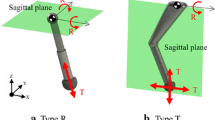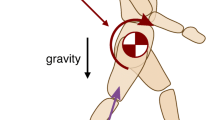Abstract
This paper explores the design of leg morphology in a six-legged robot. Inspired by nature, where animals have different leg morphology, we examined how the difference in leg morphology influences behaviors of the robot. To this end, a systematic search was conducted by scanning over the parameter space consisting of default angles of leg joints of the six-legged robot, with two main objectives: to maximize the kinematic flexibility and walking performance of the robot. Results show that (1) to have a high kinematic flexibility with both the torso and swing legs, the femur segment should tilt downwards by 5°–10° and the tibia segment should be vertically downwards or with a slight inward tilt; (2) to achieve relatively energy-efficient and steady walking, the tibia segment should be approximately vertically downwards, with the femur segment tilting upwards to lower the torso height. The results of this study suggest that behaviors of legged robots can be passively enhanced by careful mechanical design choices, thereby leading to more competent legged machines.
Similar content being viewed by others
References
Liu Q Y, Chen X D, Han B, Luo Z W, Luo X. Learning control of quadruped robot galloping. Journal of Bionic Engineering, 2018, 15, 329–640.
Liu C J, Xu T, Wang D W, Chen Q J. Active balance of humanoids with foot positioning compensation and non-parametric adaptation. Robotics and Autonomous Systems, 2016, 75, 297–309.
Zhang Z Q, Zhao J, Chen H L, Chen D S. A survey of bio-inspired jumping robot: Takeoff, air posture adjustment, and landing buffer. Applied Bionics and Biomechanics, 2017, 2017, 4780160.
Kwak B, Bae J. Locomotion of arthropods in aquatic environment and their applications in robotics. Bioinspiration & Biomimetics, 2018, 13, 041002.
Zhu H B, Luo M Z, Mei T, Zhao J H, Li T, Guo F Y. Energy-efficient bio-inspired gait planning and control for biped robot based on human locomotion analysis. Journal of Bionic Engineering, 2016, 13, 271–282.
Zhou X D, Bi S S. A survey of bio-inspired compliant legged robot designs. Bioinspiration & Biomimetics, 2012, 7, 041001.
Hutter M, Remy C D, Hoepflinger M A, Siegwart R. Efficient and versatile locomotion with highly compliant legs. IEEE/ASME Transactions on Mechatronics, 2013, 18, 449–458.
Chen D L, Li N J, Liu G F, Chen L, Wang Y Y, Liu C, Zhuang B. Effects of spine motion on foot slip in quadruped bounding. Applied Bionics and Biomechanics, 2018, 2018, 8097371.
Chen J, Jin H Z, Iida F, Zhao J. A design concept of parallel elasticity extracted from biological muscles for engineered actuators. Bioinspiration & Biomimetics, 2016, 11, 056009.
Haberland M, Kim S. On extracting design principles from biology: II. case study — The effect of knee direction on bipedal robot running efficiency. Bioinspiration & biomimetics, 2015, 10, 016011.
Daley M A, Channon A J, Nolan G S, Hall J. Preferred gait and walk-run transition speeds in ostriches measured using GPS-IMU sensors. The Journal of Experimental Biology, 2016, 219, 3301–3308.
Rubenson J, Lloyd D G, Heliams D B, Besier T F, Fournier P A. Adaptations for economical bipedal running: The effect of limb structure on three-dimensional joint mechanics. Journal of the Royal Society Interface, 2011, 8, 740–755.
Chen J, Liu Y B, Zhao J, Zhang H, Jin H Z. Biomimetic design and optimal swing of a hexapod robot leg. Journal of Bionic Engineering, 2014, 11, 26–35.
Zhong G L, Chen L, Jiao Z D, Li J F, Deng H. Locomotion control and gait planning of a novel hexapod robot using biomimetic neurons. IEEE Transactions on Control Systems Technology, 2018, 26, 624–636.
Zhao Y, Chai X, Gao F, Qi C K. Obstacle avoidance and motion planning scheme for a hexapod robot Octopus-III. Robotics and Autonomous Systems, 2018, 103, 199–212.
Smith J A, Jivraj J. Effect of hind leg morphology on performance of a canine-inspired quadrupedal robot. Journal of Bionic Engineering, 2015, 12, 339–351.
Semini C. Hyq-Design and Development of a Hydraulically Actuated Quadruped Robot, PhD thesis, University of Genoa, Genoa, Italy, 2010.
Hutter M. StarlETH & Co: Design and Control of Legged Robots with Compliant Actuation, PhD thesis, Swiss Federal Institute of Technology Zurich, Zurich, Switzland, 2013.
Lee D V, Meek S G. Directionally compliant legs influence the intrinsic pitch behaviour of a trotting quadruped. Proceedings of the Royal Society B: Biological Sciences, 2005, 272, 567–572.
Zhang H, Liu Y B, Zhao J, Chen J, Yan J H. Development of a bionic hexapod robot for walking on unstructured terrain. Journal of Bionic Engineering, 2014, 11, 176–187.
Yoshikawa T. Manipulability of robotic mechanisms. The International Journal of Robotics Research, 1985, 4, 3–9.
Cammarata A. Optimized design of a large-workspace 2-DOF parallel robot for solar tracking systems. Mechanism and Machine Theory, 2015, 83, 175–186.
Altuzarra O, Pinto C, Sandru B, Hernandez A. Optimal dimensioning for parallel manipulators: workspace, dexterity, and energy. Journal of Mechanical Design, 2011, 133, 041007.
Wang Z, Wang Z X, Liu W T, Lei Y C. A study on workspace, boundary workspace analysis and workpiece positioning for parallel machine tools. Mechanism and Machine Theory, 2001, 36, 605–622.
Zhao J S, Chu F, Feng Z J. Symmetrical characteristics of the workspace for spatial parallel mechanisms with symmetric structure. Mechanism and Machine Theory, 2008, 43, 427–444.
Hector M, Lisbeth M, Roemi F, Manuel A. Energy-efficiency hexapod walking robot for humanitarian demining. Industrial Robot: The International Journal of Robotics Research and Application, 2017, 44, 457–466.
Collins S, Ruina A, Tedrake R, Wisse M, Efficient bipedal robots based on passive-dynamic walkers. Science, 2005, 307, 1082–1085.
Seok S, Wang A, Chuah M Y, Hyun D J, Lee J, Otten D M, Lang J H, Kim S. Design principles for energy-efficient legged locomotion and implementation on the MIT cheetah robot. IEEE/ASME Transactions on Mechatronics, 2015, 20, 1117–1129.
di Prampero P E. The energy cost of human locomotion on land and in water. International Journal of Sports Medicine, 1986, 7, 55–72.
Cherouvim N, Papadopoulos E. Energy saving passive-dynamic gait for a one-legged hopping robot. Robotica, 2006, 24, 491–498.
Xi W T, Yevgeniy Y, Remy C D. Selecting gaits for economical locomotion of legged robots. The International Journal of Robotics Research, 2015, 35, 1140–1154.
Hoyt D F, Taylor C R. Gait and the energetics of locomotion in horses. Nature, 1981, 292, 239.
Umberger B R, Martin P E. Mechanical power and efficiency of level walking with different stride rates. Journal of Experimental Biology, 2007, 210, 3255–3265.
de Santos P G, Garcia E, Ponticelli R, Armada M. Minimizing energy consumption in hexapod robots. Advanced Robotics, 2009, 23, 681–704.
Sun Q, Gao F, Chen X B. Towards dynamic alternating tripod trotting of a pony-sized hexapod robot for disaster rescuing based on multi-modal impedance control. Robotica, 2018, 36, 1048–1076.
Bjelonic M, Kottege N, Homberger T, Borges P, Beckerle P, Chli M. Weaver: Hexapod robot for autonomous navigationon unstructured terrain. Journal of Field Robotics, 2018, 35, 1063–1079.
Dominik B, Przemyslaw L, Piotr S. Adaptive motion planning for autonomous rough terrain traversal with a walking robot. Journal of Field Robotics, 2016, 33, 337–370.
Rosendo A, Liu X X, Shimizu M, Hosoda K. Stretch reflex improves rolling stability during hopping of a decerebrate biped system. Bioinspiration & Biomimetics, 2015, 10, 016008.
Chatzakos P, Papadopoulos E. A parametric study on the rolling motion of dynamically running quadrupeds during pronking, Proceedings of the 17th Mediterranean Conference on Control and Automation, Thessaloniki, Greece, 2009, 754–759.
Roy S S, Singh A K, Pratihar D K. Estimation of optimal feet forces and joint torques for on-line control of six-legged robot. Robotics and Computer-Integrated Manufacturing, 2011, 27, 910–917.
Wang Z Y, Ding X L, Rovetta A. Analysis of typical locomotion of a symmetric hexapod robot. Robotica, 2009, 28, 893–907.
Xu K, Ding X L. Typical gait analysis of a six-legged robot in the context of metamorphic mechanism theory. Chinese Journal of Mechanical Engineering, 2013, 26, 771–783.
Acknowledgement
This work was supported by Natural Science Foundation of China (Grant Nos. 51805074, U1713201 and 51605082), State Key Laboratory of Robotics and System (HIT) (Grant Nos. SKLRS-2018-KF-02 and SKLRS-2017-KF-07), China Postdoctoral Science Foundation (Grant Nos. 2018M631799 and 2019T120213), Fundamental Research Funds for the Central Universities (Grant Nos. N170303007 and N180304015) and Postdoctoral Science Foundation of Northeastern University (Grant No. 20180311).
Author information
Authors and Affiliations
Corresponding authors
Rights and permissions
About this article
Cite this article
Chen, J., Liang, Z., Zhu, Y. et al. Improving Kinematic Flexibility and Walking Performance of a Six-legged Robot by Rationally Designing Leg Morphology. J Bionic Eng 16, 608–620 (2019). https://doi.org/10.1007/s42235-019-0049-9
Published:
Issue Date:
DOI: https://doi.org/10.1007/s42235-019-0049-9




